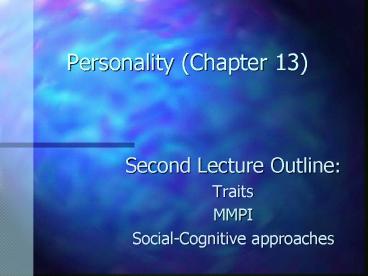Personality (Chapter 13) - PowerPoint PPT Presentation
Title: Personality (Chapter 13)
1
Personality (Chapter 13)
- Second Lecture Outline
- Traits
- MMPI
- Social-Cognitive approaches
2
How would you describe your personality to
someone?
- Please write down two traits you are high and low
on
How would your roommate (or friends) personality
to someone?
Please write down two more traits
3
Trait theory
- Nomothetic methods Everyone has a set of common
traits they can be judged on - Trait A consistent attribute that characterizes
what a person is like - Surface vs. Source traits 16 PF
- Empirical approach of factor analysis Grouping
similar behaviors or surface traits to determine
source traits
4
I am worthless
I am sad
I feel guilty
I have trouble sleeping
My energy is gone
Depression
Sex doesnt matter
5
Objective Tests of Personality
- Minnesota Multiphasic Personality Inventory
(MMPI-2) - 550 T/F items
- 3 validity scales (L, K, F)
- 10 clinical scales
- You add up items within a scale, and then compare
them to a normative sample of repsonses - Compare score Are you significantly high or
low, or somewhere in the middle average range
6
Validity Scales
- Lie scale Are they paying attention
- Examples
- I breathe every day.
- I have never brushed my teeth.
- Sometimes I have seen a truck
- There is blood flowing out of my ears
- Social desirability Do they want to be seen
favourably - Examples
- I read the newspaper editorials every day
- I always give to charities
- I like everyone I know
- I never lie
7
Normal curve of personality trait scores
T-scores
20 30 40 50 60 70 80
8
MMPI Personality profiles
Hysteria Depression Hypochondriasis Psychopathy An
drogeny Paranoia Psychasthenia Schizophrenia Mania
80 70 60 50 40 30 20
9
A small number of constructs
- Eysenck Three constructs dominate
- Extroversion Social, gregarious
- Neuroticism Moody, irritable
- Psychoticism Uncaring, detached
- Big Five
- Neuroticism
- Extroversion vs. Introversion
- Openness Imaginative, curious
- Agreeableness Good-natured, friendly
- Conscientiousness Hard-working, reliable
- There are many self-report questionnaires
10
Other traits
- Sensation-seeking Thrill seeking, sexually
adventuresome, exotic foods, drug/alcohol use,
addictive personality - Climb a mountain, eat jalapenos, drink vodka,
play poker, and have an orgy - Self-esteem Personal worth is a component of
personality - Cognitive style Can you see multiple
perspectives? This helps with coping
11
Heritability
- Temperament has continuity with adult personality
- Reactivity/ emotional regulation seems somewhat
stable - Heritability is only .40, however, and
environment has a large influence on personality
development (traumas, success) - Family surprisingly not very important
12
Social-Cognitive Approaches
- Skinner Personality shaped by reinforcement
history - Rotter Meaning is given to environmental events
- Social learning is important to personality
- Internal vs. external locus of control
- Bandura Personality X environment
- school motivation, parent reinforcement, go to
college, achieve in work world
13
Schemas
- Self-schemas Cognitive frameworks or knowledge
about self serve as personality framework What
are you? - Elaborate self-schemas is related to
introspectiveness and private self-consciousness - Overly elaborate self-schemas could reflect
narcissism or ruminative self-absorbed anxiety
14
Personal Constructs Kelly
- Personanality can be viewed in bipolar constructs
- On what dimensions do you judge people?
- Happy vs. Sad
- Socially entertaining vs. wet blanket
- Trustworthy vs. Liar
- People create their own dimensions to view the
world Idiographic methods
15
Cultural Influences
Collectivist
Individualistic
Group harmony is more important than individual
Self, individual rights are most important































